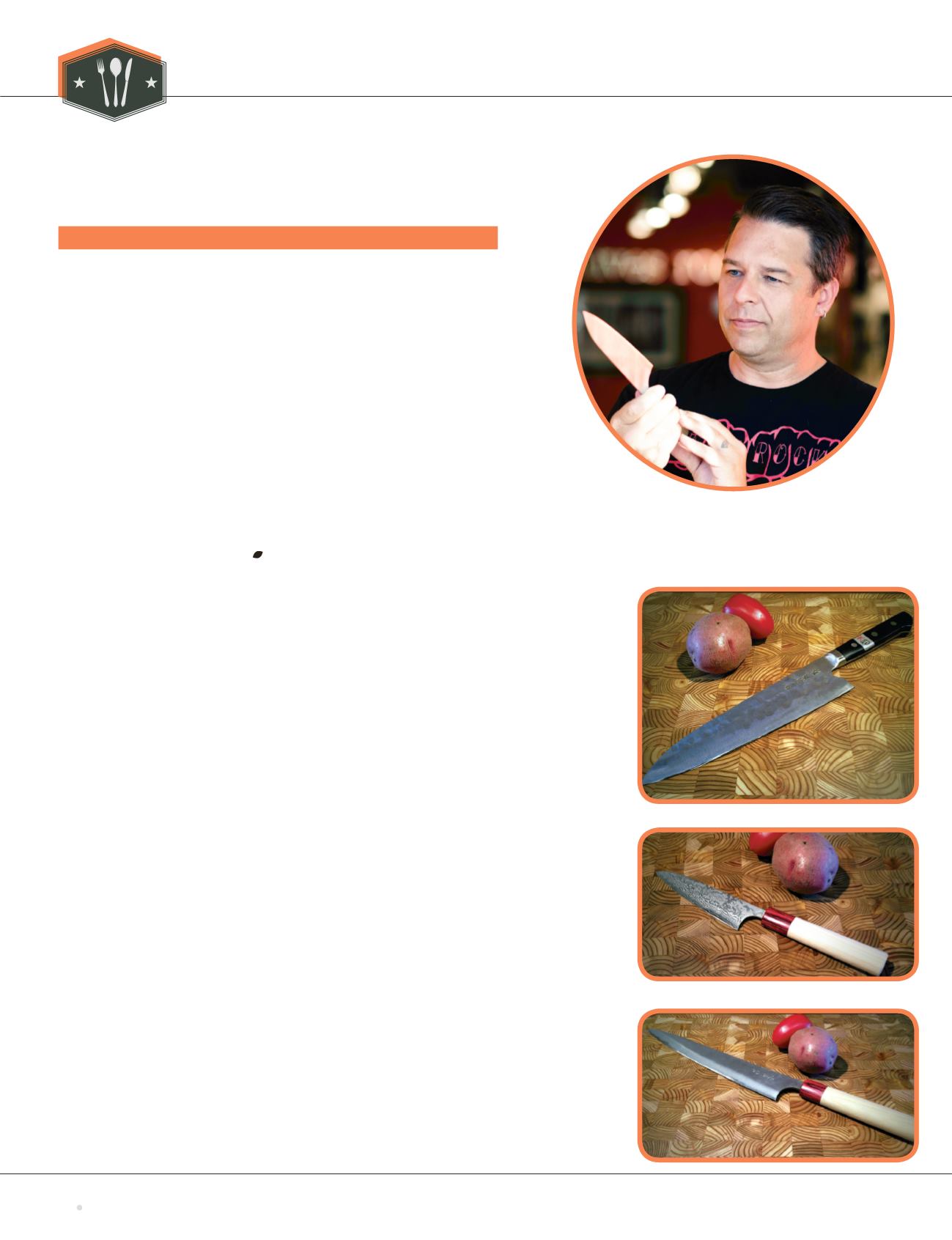
The Food Issue
2015
Grains
West
12
KITCHEN
CULTURE
BY KEVIN KENT
Youcall that aknife?
THEONLY THREE KNIVES YOU’LL EVERNEED
CHOOSING NEW KNIVES IS A DAUNTING TASK,
especially when a single store can o er hundreds of knives to
sort through. The first step is to find a store with a wide se-
lection and knowledgeable sta , and make sure you can test
many knives before you buy. I wouldn’t buy a pair of shoes that I
couldn’t try on.
Quality knives will last your entire life, so taking the time to
make the right choice is key. That being said, it doesn’t have to
be di cult. Normally, you can tell whether you love or hate a
knife the second you hold it in your hand. Each style of knife
o ers several di erent weights and balances, so it’s important
to try a few di erent models to see which one suits you best.
You really only need three knives to do almost everything in the
kitchen, but I have many more because that’s the kind of guy I
am. I love having a collection.
THE CHEF’S KNIFE
—known as
gyuto
in Japanese. These are the all-rounders. Great
for chopping vegetables, slicing small pieces of meat and many other jobs, this knife is
the one you’ll pull out all the time. I find there are two main approaches to the chef’s
knife: German and French. German-style knives tend to have a larger, more pro-
nounced curve to the blade; they’re great for those who like to rock-chop. French-style
(and most Japanese-style) knives tend to be a bit flatter, which makes them preferable
for fine vegetable and meat slicing. As these knives normally come in lengths of any-
where from 150 to 300 millimetres (six to 12 inches), every size of person can find one
that fits. Keep in mind that a long chef’s knife is suitable for more jobs, so I generally
recommend getting the largest that you’re comfortable holding. You can always choke
up on a big knife, but you can’t make a small knife longer.
My current favourite: Maboroshi 210-millimetre gyuto, handmade by Fujiwara san
THE PARING KNIFE
—often known as a petty knife. These generally come in lengths
between 75 and 150 millimetres (three and six inches), and they have a narrower profile
than a chef’s knife. For smaller jobs like peeling and coring fruit, and fine slicing jobs,
the paring knife is king. When the knife is closer to the 125- or 150-millimetre (five to
six inches) length, it is often called a utility knife. I like to use this for boning and fillet-
ing, as well as for the jobs of a paring knife. Whether you like a shorter or longer paring
knife is personal preference, though extra length does give a bit more versatility.
My current favourite: Masakage Kiri 120-millimetre petty, handmade by Kato san
THE SLICER
—known as
sujihiki
in Japanese. If the paring knife is for the jobs that a
chef’s knife is too big for, this knife is for the jobs that a chef’s knife is too small for.
Slicing primal cuts of meat into smaller steaks or chops and shaving paper-thin slices
of fish are the main things I use this for. They’re long and slender—usually over 250
millimetres (10 inches)—so you can make that slice in one smooth motion instead of
sawing. This will give you better texture for cooked and cured meat, and produce a
steak that will have even more contact with the grill or pan.
My current favourite: Masakage Yuki 270-millimetre sujihiki, handmade by Kato san
Kevin Kent is the owner of Knifewear and a self-proclaimed
knife nerd. Follow him on Twitter @KnifeNerd


